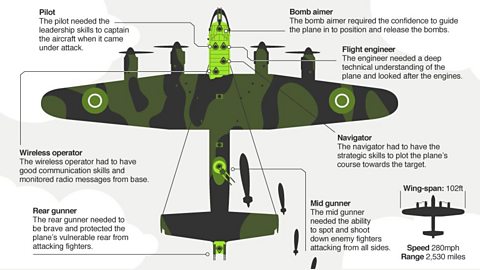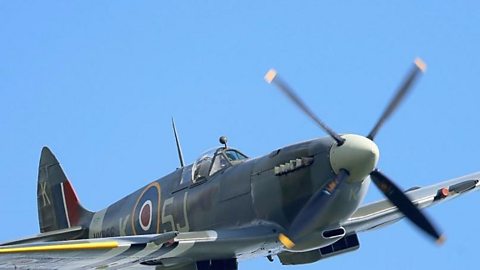The 'Lanc'
The Lancaster Bomber carried out daring missions, including the audacious Dambusters raids, on Germany during World War Two. It had a crew of seven from the pilot to the gunners. Everyone had to play their part to stay alive.
The Lancaster was one of the most dangerous places to be in the entire war ÔÇô the life expectancy of a new recruit was just two weeks. Find out if you have what it took to be part of the crew.
Which role suits you best?
A Lancaster Bomber had a crew of seven: pilot, navigator, bomb aimer, flight engineer, wireless operator, mid gunner and rear gunner. Each role needed a very particular set of skills.

Your mission
The Lancaster was the work-horse of RAF Bomber Command and the most successful bomber of World War Two. Lancaster crews took part in 156,000 missions and dropped 618,378 tons of bombs on targets in Germany and Nazi-occupied Europe. Here are some of the operations you could have faced
The ÔÇÿDambustersÔÇÖ
On 16 and 17 May 1943, a squadron, No. 617, of 19 modified Lancasters attacked dams across Germany to disrupt industrial production.
In a series of moonlit raids the Lancasters flew very low and dropped ÔÇÿbouncing bombsÔÇÖ. The missiles were designed to skim across the water, hit the dam and sink to the bottom unleashing enough explosive power to breach the structure.
Two of the four dams targeted were destroyed and the raids flooded mines, factories and houses for 50 miles. Eight of the 19 Lancasters that took part were lost with the loss of 56 men: 53 died and 3 were captured. However the mission became legendary and was a great boost to British morale.
Operation Hydra
On 17 and 18 August 1943, they took part in ÔÇÿOperation HydraÔÇÖ bombing the military test site at Peenemunde in Northern Germany. This was the home of the NazisÔÇÖ secret missile program, which was developing deadly V1 and V2 rockets.
596 planes, including 324 Lancasters dropped 1,800 tons of bombs on Peenemunde, destroying the factories and research facilities and setting back the missile program by between three and six months.
Attacking German cities
In 1942 in an attempt to break German morale the RAF began attacking German towns and cities in earnest.
On the night of 13/14 February 1945, 796 Lancasters took part in a joint British and American mission to bomb the eastern German city of Dresden. The bombers faced little resistance and around 20,000 civilians were killed. Six Lancasters were destroyed.
Learn more about this topic:
WW2: Why do we love the Spitfire? document
The spitfire is the most famous plane of WW2. Its groundbreaking design and superior specifications gave the British the critical edge in the battle for air superiority.

WW2: What was the secret to winning the Battle of Britain? document
The Battle of Britain was a pivotal moment in World War Two, when the country stood alone against Hitler's seemingly unstoppable military power. This guide explores this historic period through text and infographics.

WW2: How did the British plan to celebrate VE Day? document
VE Day or Victory in Europe Day was on 8 May 1945, following Germany's surrender in WW2. But how did Britain plan for one of the greatest days in its history?
